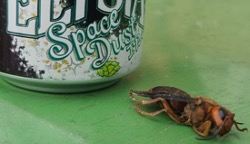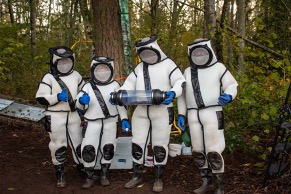
Hornets the size of golf balls may seem like something out of a sci-fi movie, but unfortunately as one Marysville, Washington resident learned, they are real and living right here in western Washington. On June 4, the first Asian giant hornet of 2021 was reported to officials in Snohomish County. The sighting was the farthest south this invasive species has been reported since it was first discovered in 2019 in British Columbia.
So, what exactly is an invasive species and why should we be concerned? “Invasive species are considered the species that have become introduced and often established outside their native ranges and cause economic or environmental impacts that are considered undesirable,” explains aquatic and fishery sciences professor and ecologist Julian Olden.
Any species that is non-native and causes harm to the local environment is considered invasive. Often, they have no natural predators to keep their population in check, and are wildly successful at outcompeting native species. Invasive species can reduce biodiversity by overwhelming an area, reducing both forage opportunities and habitat for native species.
This is of particular concern with Asian giant hornets, also known as murder hornets, who have the ability to displace entire colonies of bees native to Washington. This could have devastating impacts on beekeeping, crop pollination and the local insect population.
“Recent sightings of Asian giant hornets in Washington have prompted serious concerns that local bee populations and the ecosystem functions they provide may be in imminent danger,” says Olden.
In late September 2019 a beekeeper outside Blaine, Washington reported the first known Asian giant hornet in the United States. Less than a month later, another murder hornet was found in Blaine by another beekeeper and one more was confirmed by the Washington State Department of Agriculture (WSDA) in December. In 2020 they were detected in two more nearby towns, indicating the range of this species may be limited to the Whatcom County area.
With raised concern, WSDA issued instructions for residents to trap any giant hornets they found. In addition to setting traps, citizens were also asked to report any hornet’s whereabouts via their “Track! Don’t Whack!” campaign in order to understand their flight patterns and to determine where potential nests are located.

Information campaigns, news stories and eagerness from the public to battle this invasive species has been successful. People used orange juice and rice cooking wine traps as lures and captured both worker and queen Asian giant hornets, including one live specimen. These efforts also led to the detection and eradication of a nest in Blaine.
“These citizen scientists set traps and report suspected sightings, having a major impact on our ability to find, track and eradicate Asian giant hornet nests,” says Karla Salp, public engagement specialist for the WSDA. “Last year half of our detections and all of Canada’s detections were from public reports. Without the report that a resident made in September in the Blaine area, as well as support and assistance from the neighbors, it is unlikely that we would have found and eradicated the Asian giant hornet nest last fall.”
Last month, a resident of Marysville reported a dead Asian giant hornet, but genetic testing revealed it was not related to the Whatcom County specimens. This is important for scientists to know as people should be trapping in a wider radius from the initial nest if same genetics were indicated. Researchers at WSDA believe the specimen in Marysville arrived in the US dead and perhaps fell out of whatever it was hitching a ride on, but citizen scientist trapping efforts in Snohomish County are encouraged to be sure.
While it is still too early to determine the prognosis of the Asian giant hornet invasion in Washington state, the one year of data collected seems to indicate that the Asian giant hornet is still only in Whatcom County. “We know that, based on the fact that Asian giant hornets are an apex predator and usually nest in the ground or in tree cavities, it won’t be easy to find them, especially given the amount of suitable habitat,” says Salp. “It is going to be a very big challenge to eradicate them. That being said, everything that the public is doing to help us is really giving us a fighting chance.”
From the moment Asian giant hornets were reported in both British Columbia and Washington, the response has been a multiagency effort. The Washington Invasive Species Council received the first report and turned it over to WSDA for verification. Many state, federal, Canadian, and local agencies have since collaborated on the response. With the different roles each agency plays, it is vital to coordinate and fight the threat of Asian giant hornets together. Response agencies partners include everything from parks and recreation to transportation, researchers, public health officials, regulatory officials, scientists, insect identification experts, and citizen scientists.
What to do if you see an Asian Giant Hornet
- Take a photo if safe do so and report it to the Washington State Department of Agriculture at: agr.wa.gov/hornets, hornets@agr.wa.gov, or 1-800-443-6684.
- If you find a dead specimen, hold on to it in case it is needed for testing.
- Citizen scientist trapping started July 1. If you are interested in participating, you can gather your supplies and get ready by visiting the WSDA’s Trapping for Asian Giant Hornets website for more information.

